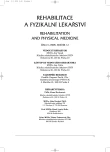Influence of Afferent Inputs on the Neurological Signs in Patients with Radicular Symptomatology
VLIV AFERENCE NA ZMĚNU VÝBAVNOSTI NEUROLOGICKÝCH PŘÍZNAKŮ U PACIENTŮ S RADIKULÁRNÍ SYMPTOMATOLOGIÍ
Radikulární syndromy v dolních segmentech bederní páteře představují velmi častý diagnostický a léčebný problém. Mechanické působení výhřezu nemusí však vždy odpovídat klinické symptomatologii. Cílem této práce je zhodnotit u nemocných s prokázanou radikulámí symptomatologii S1 vliv aference ze svalového Spoušťového bodu na průběh H-reflexu považovaného za ekvivalent napínacích šlachových reflexů L4-S2. Statistické zpracování získaných hodnot T-testem pro párové hodnoty závislých výběrů ukázalo, že terapeutické ovlivnění myofysciálního triggerpointu v m. popliteus zvýšilo signifikantně amplitudu H-reflexu (p<0,05). Tento výsledek nasvědčuje tomu, že na snížení amplitudy H-reflexu se podílí nejen poškození nervových drah, ale i aference z latentního spoušťového bodu. Pro hodnocení podílu aference na výbavnost neurologických nálezů má neinvazivní vyšetření H-reflexu značný diagnostický význam.
Klíčová slova:
H-reflex, myofasciální TrP, radikulární syndrom S1, aference
Authors:
R. Vele; R. Charalampidis; Z. Rychlý
Authors‘ workplace:
Fakulta tělesné výchovy a sportu UK, katedra fyzioterapie, Praha, vedoucí katedry PaeDr. D. Pavlů, CSc.
Published in:
Rehabil. fyz. Lék., 12, 2005, No. 1, pp. 23-26.
Category:
Original Papers
Overview
Radicular syndromes in a lower segment of lumbar spine represent an extensive diagnostic and therapeutic problem. Many times mechanic influence of disc lesion does not correspond to clinical symptomatology. Aim of this study is to demonstrate, in a patient with S1 radicular symptomatology, the influence of afferent inputs from myofascial trigger point (TrP) on the course of H-reflex. This reflex is considered as an equivalent of tendon stretch L4-S2 reflex. The results, which were statistically analysed by t-test, report significantly higher difference in the amplitude of H-reflex (p<0.05) after the therapy of myofascial TrP in m. popliteus. This result shows that the decreased value of amplitude ratio of H-reflex is caused not only by the damage of neural circuits but also by the afferent inputs of latent TrP. The H-reflex is of great importance as noninvasive diagnostic tool for the quotient assessment of afferent inputs on the neurological signs.
Key words:
H-reflex, myofascial TrP, S1 radicular syndrome, afferent inputs
Labels
Physiotherapist, university degree Rehabilitation Sports medicineArticle was published in
Rehabilitation & Physical Medicine

2005 Issue 1
- Hope Awakens with Early Diagnosis of Parkinson's Disease Based on Skin Odor
- Deep stimulation of the globus pallidus improved clinical symptoms in a patient with refractory parkinsonism and genetic mutation
Most read in this issue
- OUTFLARE – INFLARE – a Change in Position of the Pelvis
- Open and Closed Biomechanical Chains in Kinesiologic Therapeutic Practice
- Some Theoretical Remarks t o the Problems o f Open and Closed Biomechanic Chains
- Relation of Headache to Painful Muscular Spasms
